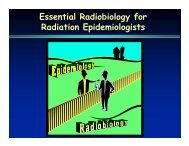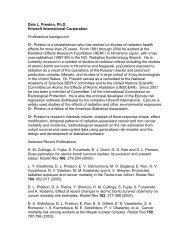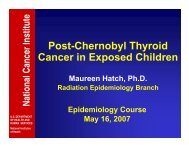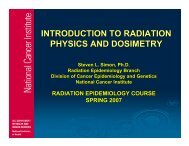dosimetry of radioactive iodine with emphasis on iodine-131
dosimetry of radioactive iodine with emphasis on iodine-131
dosimetry of radioactive iodine with emphasis on iodine-131
You also want an ePaper? Increase the reach of your titles
YUMPU automatically turns print PDFs into web optimized ePapers that Google loves.
DOSIMETRY OF RADIOACTIVE<br />
IODINE WITH EMPHASIS ON<br />
IODINE-<strong>131</strong> ( <strong>131</strong> I)<br />
<strong>131</strong> I)<br />
Steven L. Sim<strong>on</strong>, Ph.D.<br />
Radiati<strong>on</strong> Epidemiology Branch<br />
Divisi<strong>on</strong> <str<strong>on</strong>g>of</str<strong>on</strong>g> Cancer Epidemiology and Genetics<br />
Nati<strong>on</strong>al Cancer Institute<br />
RADIATION EPIDEMIOLOGY COURSE<br />
SPRING 2007
There are 37 known isotopes <str<strong>on</strong>g>of</str<strong>on</strong>g> <str<strong>on</strong>g>iodine</str<strong>on</strong>g>. The isotopes <str<strong>on</strong>g>of</str<strong>on</strong>g> <str<strong>on</strong>g>iodine</str<strong>on</strong>g> have atomic<br />
masses (A=Z+N) from 108 to 144. All have Z=53!<br />
All are unstable against <str<strong>on</strong>g>radioactive</str<strong>on</strong>g> decay except 127 I.<br />
127 I.<br />
Examples <str<strong>on</strong>g>of</str<strong>on</strong>g> Iodine Isotopes:<br />
124 125 126 127 128 129 130 <strong>131</strong> 132<br />
53<br />
I ,<br />
53<br />
I ,<br />
53<br />
I ,<br />
53<br />
I ,<br />
53<br />
I ,<br />
53<br />
I ,<br />
53<br />
I ,<br />
53<br />
I ,<br />
53<br />
I ,<br />
53<br />
I<br />
123<br />
Why are radio<str<strong>on</strong>g>iodine</str<strong>on</strong>g> isotopes used in<br />
thyroid-related diagnostic and therapeutic<br />
procedures?<br />
Iodine is <strong>on</strong>e <str<strong>on</strong>g>of</str<strong>on</strong>g> the few nuclides that<br />
can target a specific organ by virtue <str<strong>on</strong>g>of</str<strong>on</strong>g><br />
natural physiologic processes.
Examples <str<strong>on</strong>g>of</str<strong>on</strong>g> Iodine Isotopes:<br />
124 125 126 127 128 129 130 <strong>131</strong> 132<br />
53<br />
I ,<br />
53<br />
I ,<br />
53<br />
I ,<br />
53<br />
I ,<br />
53<br />
I ,<br />
53<br />
I ,<br />
53<br />
I ,<br />
53<br />
I ,<br />
53<br />
I ,<br />
53<br />
I<br />
123<br />
Which <str<strong>on</strong>g>iodine</str<strong>on</strong>g> isotopes are typically used?<br />
Iodine-123 (t 1/2<br />
= 2.3 hr): Used in diagnosis <str<strong>on</strong>g>of</str<strong>on</strong>g> thyroid functi<strong>on</strong>.<br />
Iodine-125 (t 1/2<br />
= 60 d): Used in cancer brachytherapy (prostate and brain),<br />
also diagnostically to evaluate the filtrati<strong>on</strong> rate <str<strong>on</strong>g>of</str<strong>on</strong>g> kidneys and to diagnose<br />
deep vein thrombosis in the leg; also used in radioimmuno-assays to show the<br />
presence <str<strong>on</strong>g>of</str<strong>on</strong>g> horm<strong>on</strong>es in tiny quantities.<br />
Iodine-<strong>131</strong> (t 1/2<br />
= 8 d): Widely used in treating thyroid cancer and<br />
hyperthyroidism; also in diagnosis <str<strong>on</strong>g>of</str<strong>on</strong>g> abnormal liver functi<strong>on</strong>, renal (kidney)<br />
blood flow and urinary tract obstructi<strong>on</strong>.
Examples <str<strong>on</strong>g>of</str<strong>on</strong>g> Iodine Isotopes:<br />
124 125 126 127 128 129 130 <strong>131</strong> 132<br />
53<br />
I ,<br />
53<br />
I ,<br />
53<br />
I ,<br />
53<br />
I ,<br />
53<br />
I ,<br />
53<br />
I ,<br />
53<br />
I ,<br />
53<br />
I ,<br />
53<br />
I ,<br />
53<br />
I<br />
123<br />
Why are radio<str<strong>on</strong>g>iodine</str<strong>on</strong>g> isotopes used in associated <str<strong>on</strong>g>with</str<strong>on</strong>g> nuclear weap<strong>on</strong>s<br />
fallout and nuclear reactor accidents?<br />
Nuclear fissi<strong>on</strong> <str<strong>on</strong>g>of</str<strong>on</strong>g> uranium (or plut<strong>on</strong>ium) creates intermediate size<br />
mass products, primarily <str<strong>on</strong>g>with</str<strong>on</strong>g> masses <str<strong>on</strong>g>of</str<strong>on</strong>g> 90-100 and 130-140
Most all <str<strong>on</strong>g>of</str<strong>on</strong>g> the <str<strong>on</strong>g>iodine</str<strong>on</strong>g> isotopes (except for a few meta-stable states) decay<br />
by positive or negative beta decay.<br />
Reminder about negative beta decay: the decay <str<strong>on</strong>g>of</str<strong>on</strong>g> a neutr<strong>on</strong> into a<br />
prot<strong>on</strong> which remains in the nucleus, and an electr<strong>on</strong>, which is<br />
emitted as a beta particle<br />
Negative beta decay
For I-<strong>131</strong>, there are several beta-decay possibilities, each <str<strong>on</strong>g>with</str<strong>on</strong>g> their own<br />
probability <str<strong>on</strong>g>of</str<strong>on</strong>g> decay.<br />
The energy released from β - decay if I-<strong>131</strong> is difference in the rest masses <str<strong>on</strong>g>of</str<strong>on</strong>g><br />
<str<strong>on</strong>g>iodine</str<strong>on</strong>g> and its decay product, xen<strong>on</strong>. The most important parts <str<strong>on</strong>g>of</str<strong>on</strong>g> the I-<strong>131</strong><br />
decay scheme are shown below.<br />
0.248 MeV (2.1%)<br />
0.606 MeV (90%)<br />
0.334 MeV (7.3%)<br />
0.807 MeV (0.5%)<br />
MeV
Beta Decays <str<strong>on</strong>g>of</str<strong>on</strong>g> <strong>131</strong> I (8.02 d)<br />
Gammas from <strong>131</strong> I (8.02)<br />
247.89 2.10 β -<br />
80.185 2.62 β -<br />
303.86 0.651 β -<br />
85.9 0.00009 β -<br />
333.81 7.27 β -<br />
163.93 β -<br />
606.31 89.9 β -<br />
177.21 0.270 β -<br />
629.66 0.050 β -<br />
232.18 0.0032 β -<br />
806.87 0.48 β - 284.31 6.14 β -<br />
E β endpoint (keV) I β (%) Decay mode<br />
Eγ (keV) Iγ (%) Decay mode<br />
295.8 2 0.0018 β -<br />
X-rays from <strong>131</strong> I (8.02 d)<br />
E (keV) I (%) Assignment<br />
302.4 2<br />
324.65<br />
0.0047<br />
0.0212<br />
β -<br />
β -<br />
318.09<br />
325.79<br />
0.0776<br />
0.274<br />
β -<br />
β -<br />
4.11 0.215 Xe L α1<br />
358.4 2 0.016 β -<br />
364.49 81.7 β -<br />
4.41 0.133 Xe L β1<br />
404.81 0.0547 β -<br />
29.46 1.40 Xe K α2<br />
503.00 0.360 β -<br />
29.78 2.59 Xe K α1<br />
636.99 7.17 β -<br />
33.56 0.24 Xe K β3<br />
642.72 0.217 β -<br />
33.62 0.46 Xe K β1<br />
722.91 1.773 β -<br />
34.42 0.14 Xe K β2
Whole-body nuclear medicine scan showing <str<strong>on</strong>g>iodine</str<strong>on</strong>g> gamma emissi<strong>on</strong>s<br />
Salivary<br />
glands<br />
thyroid<br />
stomach<br />
bladder<br />
123<br />
I (t 1/2<br />
=13.2 h) at 4 and 24 fhr after injecti<strong>on</strong> (158 keV γ)
The general equati<strong>on</strong> (shown yesterday) to determine the thyroid<br />
absorbed dose following an intake <str<strong>on</strong>g>of</str<strong>on</strong>g> <strong>131</strong> I is:<br />
D<br />
=<br />
A f1<br />
f2<br />
R(t)<br />
[<br />
M (a)<br />
∞<br />
n<br />
∫<br />
0<br />
T<br />
i=<br />
1<br />
∑<br />
Y<br />
i<br />
E<br />
i<br />
AF (T<br />
i<br />
← S,a)]dt
Some typical assumpti<strong>on</strong>s that affect the estimated dose:<br />
1) The kinetic energy <str<strong>on</strong>g>of</str<strong>on</strong>g> beta particles and phot<strong>on</strong>s
Thyroid gland mass increases <str<strong>on</strong>g>with</str<strong>on</strong>g> age and is <strong>on</strong>e reas<strong>on</strong><br />
why absorbed dose decreases <str<strong>on</strong>g>with</str<strong>on</strong>g> age.<br />
Figure from NCI (1997).
Thyroid uptake decreases immediately after birth.<br />
Figure from NCI (1997).
In the dose equati<strong>on</strong>, <strong>on</strong>ly R(t) has any time-dependence <str<strong>on</strong>g>with</str<strong>on</strong>g>in the short half-life<br />
<str<strong>on</strong>g>of</str<strong>on</strong>g> 8 days. The age dependence arises from the AF i<br />
(T←S,a) and M T<br />
(a).<br />
Absorbed Dose (Gy) Received per Bq <str<strong>on</strong>g>of</str<strong>on</strong>g> <strong>131</strong> I Ingested for Selected Organs<br />
(ICRP 1989)<br />
ORGAN 3 mos 1 Year 5 Year 10 Year 15 Year Adult<br />
Bladder wall 3.70E-10 2.40E-10 1.30E-10 7.30E-11 4.50E-11 3.80E-11<br />
Breast 5.60E-10 4.10E-10 2.30E-10 1.50E-10 7.30E-11 5.80E-11<br />
Stomach wall 3.40E-09 2.00E-09 9.80E-10 5.6E-10 3.80E-10 3.00E-10<br />
Liver 4.60E-10 3.20E-10 1.70E-10 9.8E-11 5.90E-11 4.70E-11<br />
Ovaries 3.90E-10 2.70E-10 1.40E-10 7.80E-11 4.70E-11 4.00E-11<br />
Testes 3.40E-10 2.30E-10 1.10E-10 6.60E-11 4.00E-11 3.40E-11<br />
Thymus 2.30E-09 1.70E-09 8.50E-10 4.70E-10 2.30E-10 1.50E-10<br />
Thyroid 3.70E-06 3.60E-06 2.10E-06 1.10E-06 6.90E-07 4.40E-07<br />
Note: these values, while are useful for clinical applicati<strong>on</strong>s, are <strong>on</strong>ly for a<br />
typical pers<strong>on</strong>.
Note: The true thyroid absorbed dose received an individual is<br />
not <strong>on</strong>ly a functi<strong>on</strong> <str<strong>on</strong>g>of</str<strong>on</strong>g> the administered activity, but also a<br />
functi<strong>on</strong> <str<strong>on</strong>g>of</str<strong>on</strong>g>:<br />
• Individual biokinetics (functi<strong>on</strong> <str<strong>on</strong>g>of</str<strong>on</strong>g> health status), and<br />
• Amount <str<strong>on</strong>g>of</str<strong>on</strong>g> stable <str<strong>on</strong>g>iodine</str<strong>on</strong>g> in the diet.
What are typical therapeutic dosages <str<strong>on</strong>g>of</str<strong>on</strong>g> I-<strong>131</strong> and typical<br />
absorbed doses?<br />
Treatment <str<strong>on</strong>g>of</str<strong>on</strong>g> hyperthyroidism:<br />
Dosages <str<strong>on</strong>g>of</str<strong>on</strong>g> 200 to 500 MBq<br />
Target absorbed doses <str<strong>on</strong>g>of</str<strong>on</strong>g> ~70 Gy<br />
Destructi<strong>on</strong> <str<strong>on</strong>g>of</str<strong>on</strong>g> tumor remnants after incomplete tumor surgery:<br />
Dosages <str<strong>on</strong>g>of</str<strong>on</strong>g> 1 to 10 GBq (10 9 Bq)<br />
Target absorbed doses <str<strong>on</strong>g>of</str<strong>on</strong>g> >400 Gy
Though I will not discuss doses from I-<strong>131</strong> I<br />
in<br />
fallout, if you were born in the U.S. before 1951,<br />
you might be interested to estimate your dose<br />
from <str<strong>on</strong>g>radioactive</str<strong>on</strong>g> fallout:<br />
http://ntsi<strong>131</strong>.nci.nih.gov/












